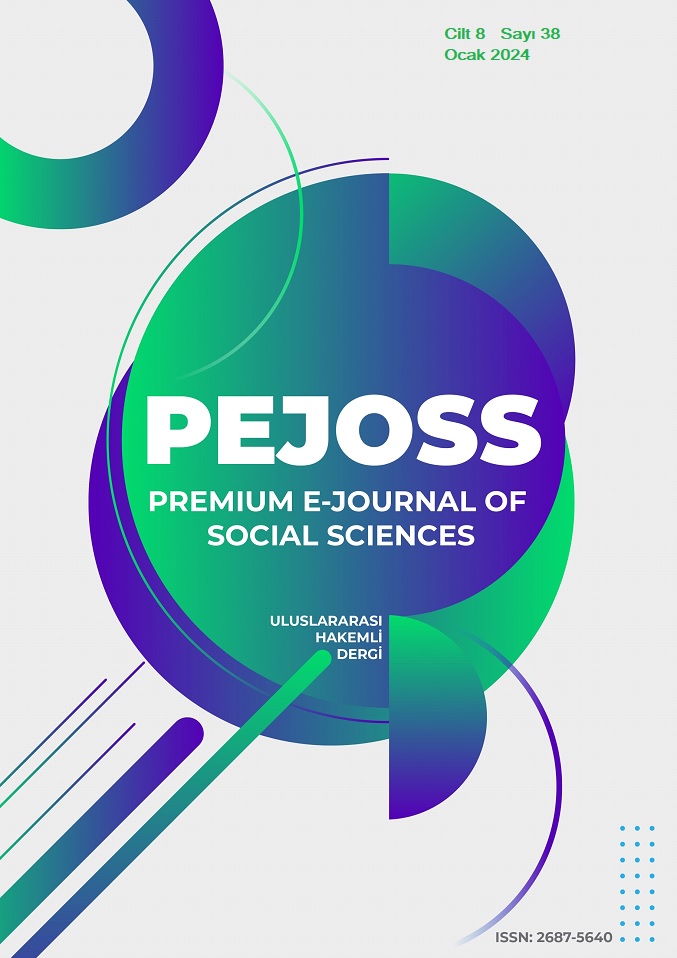The Utilization Of Artificial Intelligence And Metaverse In Public Relations Practices: Global And Turkish Contexts
DOI:
https://doi.org/10.5281/zenodo.10642722Keywords:
Public Relations, Artificial Intelligence, MetaverseAbstract
Public relations, like any other institution, functions and sustains its presence in the metaverse era by leveraging various artificial intelligence capabilities and functionalities, requiring compatibility and synchronicity with different AI elements.
In the metaverse space, public relations can overcome obstacles such as low interaction quality by utilizing artificial intelligence technologies and offering new services to audiences, such as live virtual conferences. Employing artificial intelligence in the metaverse, public relations can assess societal opinions, conduct corporate virtual promotions, and provide a virtual shape to education and organizations.
The fundamental question in this article revolves around the relationship between public relations and artificial intelligence, focusing on the impact of artificial intelligence on public relations in the future. The study commences by examining the history and definition of artificial intelligence and subsequently delves into exploring the diverse functionalities of artificial intelligence in the context of the metaverse. Additionally, attention is directed toward the necessities of artificial intelligence in public relations within the metaverse and the significance of artificial intelligence in the context of public relations. The methodology employed in this study involves compiling up-to-date information through a literature review and online sources.
Downloads
References
Allbeck, J. & Badler, N. (1998). Avatars A La Snow. University of Pennsylvania Press.
Baydoğan, V. C. & Alatas, B. (2021). Çevrimiçi Sosyal Ağlarda Nefret Söylemi Tespiti için Yapay Zeka Temelli Algoritmaların Performans Değerlendirmesi. Fırat Üniversitesi Mühendislik Bilimleri Dergisi, 33(2), 745-754. https://doi.org/10.35234/fumbd.986500.
Bina, O., Inch, A., & Pereira, L. (2020). Beyond techno-utopia and its discontents: On the role of utopianism and speculative fiction in shaping alternatives to the smart city imaginary. Futures, 115, 102475.
Cellat, M. (2023). Yerel Yönetimlerde Metaverse Denemeleri: Türkiye ve Güney Kore Örneği. Kamu Yönetimi Ve Teknoloji Dergisi, 5(1), 26-50. https://doi.org/10.58307/kaytek.1257990.
Crevier, D. (1993). Ai: The Tumultuous Search for Artificial Intelligence. New York basic books https://www.researchgate.net/publication/233820788_AI_The_Tumultuous_History_of_the_searvh-for-Artificial -intelligence.
Duran, C. (2021). Yapay zekâ temelli pazarlama: Geleneksel pazarlamanın sonu mu?. Ö. İyigün ve M. K. Yılmaz (Ed.), Yapay zekâ: güncel yaklaşımlar ve uygulamalar içinde (s. 31–50), İstanbul: Beta.
Flujas-Contreras, J. M., García-Palacios, A., & Gómez, I. (2019). Technology-based parenting interventions for children’s physical and psychological health: a systematic review and meta-analysis. Psychological Medicine, 49(11), 1787–1798.
Gacar, A. (2019). Yapay Zekâ ve Yapay Zekânın Muhasebe Mesleğine Olan Etkileri: Türkiye’ye Yönelik Fırsat ve Tehditler. Balkan Sosyal Bilimler Dergisi, 8, 389-394.
Gulyamov, Said. ve Bakhramova, M. (2022). Digitalization of International Arbitration and Dispute Resolution by Artificial Intelligence. World Bulletin of Management and Law .9.79-85.
Hansell, G. (2023). 13 Ways AI Will Impact Public Relations Over The Next Decade. SLXMarketing.http://slx.marketing/ai-for-marketing/13-ways-ai-will-impact-public-relations-over-the-next-decade/.
Haton, J., ve Haton, M. (1991). Yapay Zeka. İletişim Yayinları.
Hekmat, S. (2023). Yapay Zekanın Tarihi. U-ID. https://blog.u-id.net/history-of-artificial-inteligence/.
Knight, K. Be Rich, E. (2010). Artificial intelligence, Mc graw, hill India.
Kurt, D. ve Bozoklu, Ü. (2019). Robot Ekonomisinin Yükselişi. Sosyal Bilimler Metinleri, 2019(1), 25-47.
Lewis, T. (2014). A Brief History of Artificial Intelligence. LiveScience Retrieved.
Liu, B. ve Zhang, L. (2012), A Survey of Opinion Mining and Sentiment Analysis. Mining Text Data, (eds.) Charu C. Aggarwal, ChengXiang Zhai, Springer, Boston, MA.415-463.
Luger, G. Ve Stubblefield, w. (2004). Artificial İnteligence: Sturctures and Strategies for complex problem solving (5th edition) Benjamin/ Cummings. 3-31.
Maccorduk, P. (2004). Machines Who Think, 2nd edition .Natick m.a, ak, Peters ltN. 59-84
McCulloch, W.S., & Pitts, W. (1943). A Logical Calculus of the Ideas Immanent in Nervous Activity. Bulletin of Mathematical Biophysics, (5), 115-137.
Newquist, HP. (1994). The Brain Makers. Genius ego. And greed in The Quest for Machines That Think. New York. MacMillan.intel.
Nilsson, N. (1998). Artificial İnteligence: a new synthesis. Morgan kaufmann.
Nilsson, N. (2009). The Quest For Artificial Intelligence: A History of Ideas And Achievements. New York. Cambridge University press.
Öztürk, K., & Şahin, M. E. (2018). Yapay Sinir Ağları ve Yapay Zekâ’ya Genel Bir Bakış. Takvim-I Vekayi, 6(2), 25-36.
Poole, D. Mackworth, A., ve Goebel, R. (1998). Computational Intelligence: A Logical Intelligence. Oxford University press.
Poole, D., & Mackworth, A. (2017) Artificial intelligence: foundations of computational agents(2nd edition) Cambridge University press.
Rahimian, Z. (2023). Yapay Zekanın Kavrayışı. Cafetadris. https://cafetadris.com/blog/.
Reiter, E., & Dale, R. (1997). Building Natural Language Generation Systems. Natural Language Engineering, 3(1), 57–87 DOI: https://doi.org/10.1017/S1351324997001502.
Russell, S j., & Norving, P. (2003). Artificial intelligence: a modern approach (2nd edition) Upper saddle river. New Jersey. Prentice hall. 5-28.
Russell, S. j., & Norving, P. (2009) Artificial intelligence: a modern approach (3rd edition) Upper saddle river. Prentice hall.
Russell, S. j., & Norving, P. (2021) Artificial intelligence: a modern approach (4th edition). Hoboken, Pearson.
Saltık Yaman, E. (2023). Halkla İlişkilerin Gelecek Öngörüsü. Uluslararası Halkla İlişkiler Ve Reklam Çalışmaları Dergisi, 6(2), 99-120.
Agency. (2021). Yapay Zeka Ve Sosyal Medya İlişkisi. Https://1618.agency/blog-detay/yapay-zeka-ve-sosyal-medya-Iliskisi.
Shaoying, P., Pengzhi, C., Xinru, F., Lifu, Q., Junhui, H., and Liwen, J. (2022). Ten conjectures: Interpretation of the development trend of the most comprehensive metaverse. IT Times.Available at:https://m.jiemian.com/article/7078158.html
Şeker, M., Yıldırım, E. S., ve Berkay, A. (2004). Yapay Sinir Ağlarının Ekonomik Tahminlerde Kullanılması. Pamukkale Üniversitesi Mühendislik Bilimleri Dergisi, 10(4), 79-83.
Yazar, E. (2023). Uluslararası Hukukta Yapay Zekâ Teknolojisi. Uluslararası Yönetim Akademisi Dergisi, 6(2), 537-553. https://doi.org/10.33712/mana.1254524
Yücel, G. ve Adiloğlu, B. (2019). Dijitalleşme-yapay zeka ve muhasebe beklentiler. Muhasebe ve Finans Tarihi Araştırmaları Dergisi, (17), 47-60.
Wright, M., Ekeus, H., Coyne, R., Stewart, J., Travlou, P., & Williams, R. (2008). Augmented duality: overlapping a metaverse with the real world. In ACE '08 Proceedings of the 2008. International Conference on Advances in Computer Entertainment Technology. (pp. 263-266).
Zawacki-Richter, O., & Marín, V., & Bond, M., & Gouverneur, F. (2019). Systematic review of research on artificial intelligence applications in higher education -where are the educators? International Journal of Educational Technology in Higher Education. 16, 1-27. 10.1186/s41239-019-0171-0.
Downloads
Published
How to Cite
Issue
Section
License
Copyright (c) 2024 Premium e-Journal of Social Science (PEJOSS)

This work is licensed under a Creative Commons Attribution 4.0 International License.


